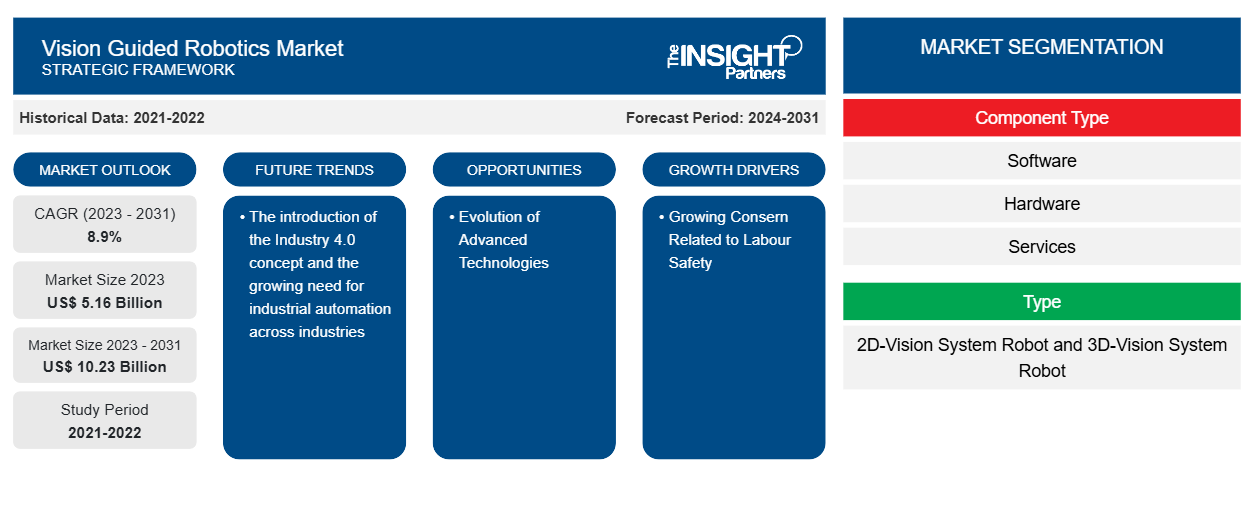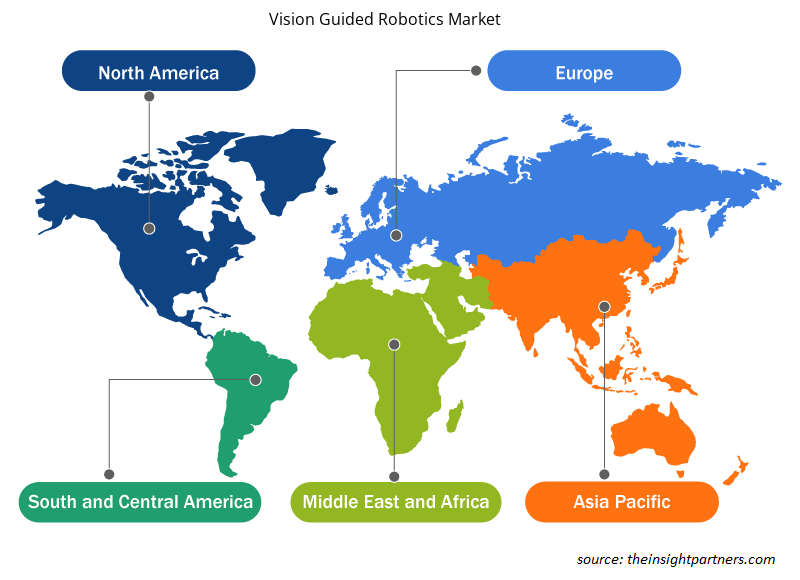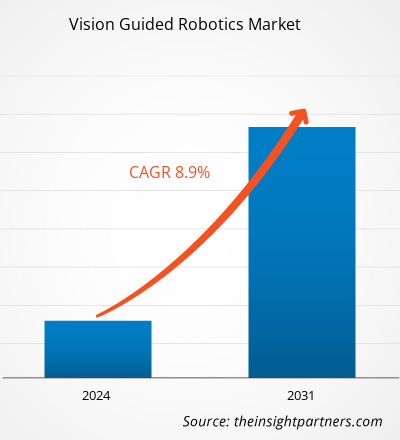The vision guided robotics market size is projected to reach US$ 10.23 billion by 2031 from US$ 5.16 billion in 2023. The market is expected to register a CAGR of 8.9% in 2023–2031. The introduction of the Industry 4.0 concept and the growing need for industrial automation across industries is likely to remain a key vision guided robotics market trend.
Vision Guided Robotics Market Analysis
The vision guided robotics market is growing at a rapid pace due to the growing concern related to labor safety, increased demand for quality inspection and control among industries, and rising adoption of vision guided robotics in SMEs. The market is expanding steadily, driven by the growing use of collaborative robots in collaborative manufacturing settings. Moreover, the evolution of advanced technologies and developments in machine vision technology is providing lucrative opportunities for market growth.
Vision Guided Robotics Market Overview
Vision guided robotics is a robotics system that employs computer vision algorithms and cameras to allow robots to accomplish tasks requiring visual perception and interpretation. The primary idea behind vision guided robotics is to give robots the ability to see and understand their surroundings, allowing them to navigate, interact with things, and perform tasks more accurately and efficiently. Vision guided robots often use high-resolution cameras, modern image processing, and machine learning algorithms to assess visual data and make judgments based on it. Vision-guided robotics is commonly used for pick-and-place activities, assembly and inspection, packaging, and quality control. The growing adoption of vision guided robotics in numerous industries, such as automotive, aerospace & defense, food & beverages, electrical & electronic, healthcare & pharmaceutical, metal processing, and others, is driving the market.
Customize This Report To Suit Your Requirement
You will get customization on any report - free of charge - including parts of this report, or country-level analysis, Excel Data pack, as well as avail great offers and discounts for start-ups & universities
Vision Guided Robotics Market: Strategic Insights

- Get Top Key Market Trends of this report.This FREE sample will include data analysis, ranging from market trends to estimates and forecasts.
You will get customization on any report - free of charge - including parts of this report, or country-level analysis, Excel Data pack, as well as avail great offers and discounts for start-ups & universities
Vision Guided Robotics Market: Strategic Insights

- Get Top Key Market Trends of this report.This FREE sample will include data analysis, ranging from market trends to estimates and forecasts.
Vision Guided Robotics Market Drivers and Opportunities
Growing Consern Related to Labour Safety is Driving the Market
As international labor safety requirements become more stringent, industries across the globe are shifting their preference toward the adoption of robots by replacing human workers in dangerous areas. Robots can perform tasks that are harmful and unsafe for humans, which increases their demand in hazardous areas, including operating in harsh terrains and managing hazardous substances. Industries can reduce risks, and the number of workplace accidents by using robots in certain risky environments is fueling the vision guided robotics market during the forecast period.
Evolution of Advanced Technologies – An Opportunity in the Vision Guided Robotics Market
The introduction of new technology has resulted in the development of more effective and efficient robotics in the market. These technologically advanced robots can do tasks with higher accuracy and precision, which leads to lower costs. Hence, creating opportunities in the market growth during the forecast period.
Technological advancements have made robotics systems more compact and modular, resulting in higher-quality, more versatile robots. The growing usage of augmented and modular robots is generating significant growth opportunities for the market in the near future.
Vision Guided Robotics Market Report Segmentation Analysis
Key segments that contributed to the derivation of the vision guided robotics market analysis are component type, type, and industry vertical.
- Based on component type, the vision guided robotics market is divided into software, hardware, and services. The hardware segment held a larger market share in 2023.
- On the basis of type, the market is segmented into 2D-vision system robot and 3D-vision system robot. The 3D-vision system robot segment held a larger market share in 2023.
- In terms of industry vertical, the market is categorized as automotive, aerospace & defense, food & beverages, healthcare & pharmaceutical, electrical & electronic, metal processing, and others. The automotive segment held a larger market share in 2023.
Vision Guided Robotics Market Share Analysis by Geography
The geographic scope of the vision guided robotics market report is mainly divided into five regions: North America, Asia Pacific, Europe, Middle East & Africa, and South America/South & Central America.
In terms of revenue, Asia Pacific accounted for the largest vision guided robotics market share, due to the emerging technologies and high volume of manufacturing capabilities. Furthermore, the growing deployment of the Industry 4.0 concept and increasing investment from businesses to set up manufacturing facilities are expected to fuel demand throughout the projection period.
Vision Guided Robotics Market News and Recent Developments
The vision guided robotics market is evaluated by gathering qualitative and quantitative data post primary and secondary research, which includes important corporate publications, association data, and databases. The following is a list of developments in the market for vision guided robotics and strategies:
- In March 2023, Smart Vision Lights co-sponsors Quality Magazine’s webinar that looks into the recent evolution of vision-guided robotics and helps guide companies looking for new automation solutions. The webinar will service everyone interested in vision-guided robotics technology including company, quality, and plant management and engineering and operations regardless of marketplace. (Source: Smart Vision Lights, Press Release, 2023)
Vision Guided Robotics Market Report Coverage and Deliverables
The “Vision Guided Robotics Market Size and Forecast (2023–2031)” report provides a detailed analysis of the market covering below areas:
- Market size and forecast at global, regional, and country levels for all the key market segments covered under the scope
- Market dynamics such as drivers, restraints, and key opportunities
- Key future trends
- Detailed PEST/Porter’s Five Forces and SWOT analysis
- Global and regional market analysis covering key market trends, major players, regulations, and recent market developments
- Industry landscape and competition analysis covering market concentration, heat map analysis, prominent players, and recent developments
- Detailed company profiles
Vision Guided Robotics Market Regional Insights
The regional trends and factors influencing the Vision Guided Robotics Market throughout the forecast period have been thoroughly explained by the analysts at The Insight Partners. This section also discusses Vision Guided Robotics Market segments and geography across North America, Europe, Asia Pacific, Middle East and Africa, and South and Central America.

- Get the Regional Specific Data for Vision Guided Robotics Market
Vision Guided Robotics Market Report Scope
| Report Attribute | Details |
|---|---|
| Market size in 2023 | US$ 5.16 Billion |
| Market Size by 2031 | US$ 10.23 Billion |
| Global CAGR (2023 - 2031) | 8.9% |
| Historical Data | 2021-2022 |
| Forecast period | 2024-2031 |
| Segments Covered |
By Component Type
|
| Regions and Countries Covered | North America
|
| Market leaders and key company profiles |
Vision Guided Robotics Market Players Density: Understanding Its Impact on Business Dynamics
The Vision Guided Robotics Market is growing rapidly, driven by increasing end-user demand due to factors such as evolving consumer preferences, technological advancements, and greater awareness of the product's benefits. As demand rises, businesses are expanding their offerings, innovating to meet consumer needs, and capitalizing on emerging trends, which further fuels market growth.
Market players density refers to the distribution of firms or companies operating within a particular market or industry. It indicates how many competitors (market players) are present in a given market space relative to its size or total market value.
Major Companies operating in the Vision Guided Robotics Market are:
- ABB Ltd.
- Basler AG
- Cognex
- Denso Corporation
- Fanuc Corporation
- ISRA Vision
Disclaimer: The companies listed above are not ranked in any particular order.

- Get the Vision Guided Robotics Market top key players overview
Frequently Asked Questions
What is the estimated market size for the global vision guided robotics market in 2023?
The global vision guided robotics market was estimated to be US$ 5.16 billion in 2023 and is expected to grow at a CAGR of 8.9% during the forecast period 2023 - 2031.
What are the driving factors impacting the global vision guided robotics market?
The growing concern related to labor safety, increased demand for quality inspection and control among industries, and rising adoption of vision guided robotics in SMEs are the major factors that propel the global vision guided robotics market.
What are the future trends of the global vision guided robotics market?
The introduction of the Industry 4.0 concept and the growing need for industrial automation across industries will play a significant role in the global vision guided robotics market in the coming years.
Which are the key players holding the major market share of the global vision guided robotics market?
The key players holding majority shares in the global vision guided robotics market are ABB Ltd., Basler AG, Cognex, Denso Corporation, and Fanuc Corporation.
What will be the market size of the global vision guided robotics market by 2031?
The global vision guided robotics market is expected to reach US$ 10.23 billion by 2031.
What is the incremental growth of the global vision guided robotics market during the forecast period?
The incremental growth expected to be recorded for the global vision guided robotics market during the forecast period is US$ 5.07 billion.
- Historical Analysis (2 Years), Base Year, Forecast (7 Years) with CAGR
- PEST and SWOT Analysis
- Market Size Value / Volume - Global, Regional, Country
- Industry and Competitive Landscape
- Excel Dataset
Testimonials
Reason to Buy
- Informed Decision-Making
- Understanding Market Dynamics
- Competitive Analysis
- Identifying Emerging Markets
- Customer Insights
- Market Forecasts
- Risk Mitigation
- Boosting Operational Efficiency
- Strategic Planning
- Investment Justification
- Tracking Industry Innovations
- Aligning with Regulatory Trends
Yes! We provide a free sample of the report, which includes Report Scope (Table of Contents), report structure, and selected insights to help you assess the value of the full report. Please click on the "Download Sample" button or contact us to receive your copy.
Absolutely — analyst assistance is part of the package. You can connect with our analyst post-purchase to clarify report insights, methodology or discuss how the findings apply to your business needs.
Once your order is successfully placed, you will receive a confirmation email along with your invoice.
• For published reports: You’ll receive access to the report within 4–6 working hours via a secured email sent to your email.
• For upcoming reports: Your order will be recorded as a pre-booking. Our team will share the estimated release date and keep you informed of any updates. As soon as the report is published, it will be delivered to your registered email.
We offer customization options to align the report with your specific objectives. Whether you need deeper insights into a particular region, industry segment, competitor analysis, or data cut, our research team can tailor the report accordingly. Please share your requirements with us, and we’ll be happy to provide a customized proposal or scope.
The report is available in either PDF format or as an Excel dataset, depending on the license you choose.
The PDF version provides the full analysis and visuals in a ready-to-read format. The Excel dataset includes all underlying data tables for easy manipulation and further analysis.
Please review the license options at checkout or contact us to confirm which formats are included with your purchase.
Our payment process is fully secure and PCI-DSS compliant.
We use trusted and encrypted payment gateways to ensure that all transactions are protected with industry-standard SSL encryption. Your payment details are never stored on our servers and are handled securely by certified third-party processors.
You can make your purchase with confidence, knowing your personal and financial information is safe with us.
Yes, we do offer special pricing for bulk purchases.
If you're interested in purchasing multiple reports, we’re happy to provide a customized bundle offer or volume-based discount tailored to your needs. Please contact our sales team with the list of reports you’re considering, and we’ll share a personalized quote.
Yes, absolutely.
Our team is available to help you make an informed decision. Whether you have questions about the report’s scope, methodology, customization options, or which license suits you best, we’re here to assist. Please reach out to us at sales@theinsightpartners.com, and one of our representatives will get in touch promptly.
Yes, a billing invoice will be automatically generated and sent to your registered email upon successful completion of your purchase.
If you need the invoice in a specific format or require additional details (such as company name, GST, or VAT information), feel free to contact us, and we’ll be happy to assist.
Yes, certainly.
If you encounter any difficulties accessing or receiving your report, our support team is ready to assist you. Simply reach out to us via email or live chat with your order information, and we’ll ensure the issue is resolved quickly so you can access your report without interruption.





















 Get Free Sample For
Get Free Sample For